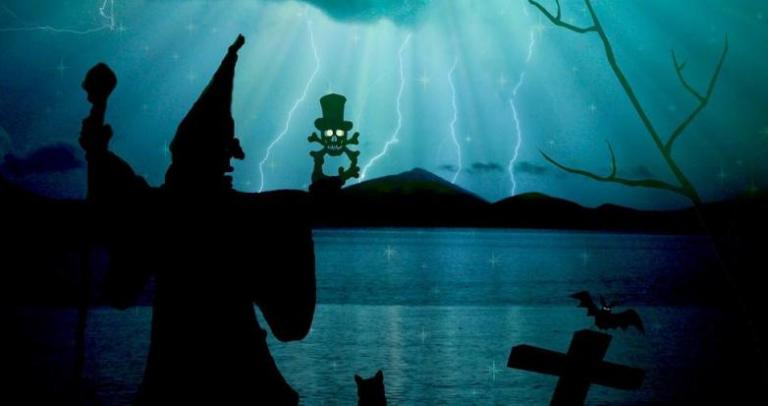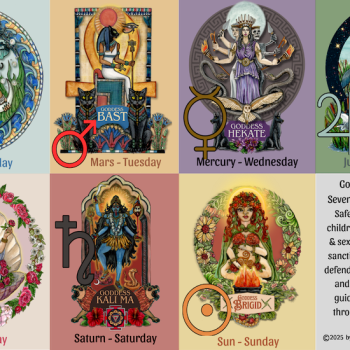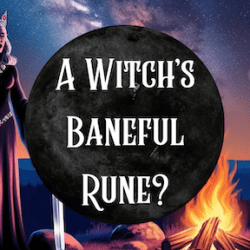The Bagabi Incantation is often associated with witchcraft rituals at Samhain, and with initiations in British Wicca. I’ve also seen it used by Modern Witches to raise power for magickal workings, and to summon Spirits. But where does the Bagabi incantation come from? Does it conjure the “devil,” or invite witches to come scrub the Samhain feast dishes? As per standard witching procedure, there are a host of varying opinions. Either way, it has summoning power.
Rutebeuf: Summoning the Devil?
Just about every source I’ve found references a french play from the 13th Century called, Le Miracle de Théophile, by the trouvère Rutebeuf as the first known printed use of this incantation. From an article in wikipedia:
“The play is a religious drama…[that] refers to the legendary history of St. Theophilus of Adana, who according to traditional saints’ legends made a pact with the Devil and repented of it…This play is the original source of an influential invocation to the Devil (in an unknown language)…given to the character Salatin…labelled a sorcerer; Salatin uses these words to invoke the Devil:
- (Ci conjure Salatins le deable.)
- Bagahi laca bachahé,
Lamac cahi achabahé,
- Karrelyos.
- Lamac lamec bachalyos,
Cabahagi sabalyos,
- Baryolas.
- Lagozatha cabyolas,
Samahac et famyolas,
- Harrahya.
Some postulate that Rutebeuf just made up some mystical sounding gibberish a sorcerer might say, and it was not sourced from witchcraft at all.

Gerald Gardner: Initiations and Samhain Rites?
Gerald Gardner, father of British Wicca and infamous for his syncretism, may have been familiar with Rutebeuf’s play – or the later occult texts that lifted it from the play – because the Bagabi incantation is used in his novel, High Magic’s Aid. One version of the Bagabi chant can -allegedly- be found in the Gardnerian Book of Shadows, and so tends to be incorporated into the practices of those who inherited his Wiccan tradition. Though, they did not claim to know what the words meant. Rumor has it that Wiccans use it for initiations and a power raising call to Samhain Rites.
Aleister Crowley: Barbarous Words of Power?
In occult magickal systems like Thelema, there is a concept known as the Barbarous Names of Power.
From the Thelemapedia:
“Crowley concluded that ‘the most potent conjurations are those in an ancient and perhaps forgotten language, or even those couched in a corrupt and possibly meaningless jargon.’ (Magick, p. 187) Barbarous Names used in evocation serve the purpose of exalting the mind from the vulgar world through a release from rational, discursive thought. They are a mechanism for provoking ecstatic consciousness.”
Aleister Crowley also wrote this in “Eleusis” (Epilogue and Dedication of Collected Works, 1906) “It is because the names are senseless that they are effective. If a man is really praying he can’t bring himself to utter ridiculous things to his God, just as Mark Twain observes that one “cannot pray a lie.” So that it is a sublime test of faith to utter either a lie or a jest, this with reverence, and that with conviction. Achieve it; the one becomes the truth, the other a formula of power.”
I agree and would add that “barbarous words” conjure power by tapping the egregore (1) created by generations of magi intoning them with similar intent. Basically, if enough witches channel power through the same words, with the same purpose, for long enough, those words take on a life of their own. Then any schmo-witch who chants them taps that powerful keg just by speaking them aloud.
I’ve spent a fair amount of time chanting these words while attempting to memorize them, and I can tell you that big energy shifts DO happen, and time does strange things for me while I’m down that particular rabbit hole. It drops me into a deep trance quite effectively. To hear it sung, or droned in a magickal circle in the firelight, is spine-tingling, and sets the stage for some witchy business.
Michael Harrison: Basque invitation to do the dishes?
But does anyone actually know where it came from or what it was originally supposed to mean? Michael Harrison spent time diving deeply into these questions. In his book The Roots of Witchcraft he examined the etymology including a traditional first line as chanted by a priestess at Witchcraft initiations. He cites his sources:
“The chant is given both in Peter Railing’s The Warlock’s Book (W.H. Allen, London, 1971) and Raymond Lament Brown’s A Book of Witchcraft (David & Charles, Newton Abbot, 1971). I shall give the Haining version here…” p.123Eko: Eko: Azarak; Eko: ZomelakBagohi Lacha bachabeLamac cahi achababeKarellyosLamac lamac BachalyasCabahagy sabalyosBaryolosLagos atha cabyolasSamahac atha famolasHurrahya.
Harrison makes a compelling linguistic case for these words being derived from the old Basque language. The Basque are a people who live on the Spanish side of the Pyrenees mountains, and have been linked to Witchery since the famous Witch Trials at Logrono, held by the Spanish Inquisition 1609-1611. Harrison has a different translation of the Bagabi Incantation – having little to do with initiation, nor even of summoning the devil. His translation based on ancient Basque language is more of a rallying cry for witches to gather for the work of the slaughter and harvest, and then share in feast and toasting at the first of November. Its an invitation to come party and then help wash the dishes!
One possible English version – by Harrison:
Kill (or the Feast) in November; kill!
I shall transport thee there myself,
and without the aid of a sieve,
to scour the plates and dishes with sand:
work (which must be done) with those plates and dishes.
(We shall meet our friends) ready for the drinking-cup
if they shall go (to the Feast), their bellies full with
quaffing from the drinking-cup.
O Sons (of the Master) with your Families (shout His praises with the cry)’.
‘HURRAHYA’!
On the flip-side, in Wicca: Magickal Beginnings, historians Sorita D’Este and David Rankine discuss the origins and usages of the Bagabi, and are skeptical of the Harrison-Basque translation, adding: “No linguistic equivalent in any language, or barbarous version in grimoires or old magickal papyri seems to exist for this particular chant. However, considering the villain in the original tale of Theophilus is a Jewish Magician, it is possible that the Bagabi is in fact a corrupted Hebrew Chant.” page 184
William Shakespeare: Witches Travel in Sieves?
However, the mention of the sieve in Harrison’s translation could be indicative of a connection to Witchcraft because in the transcripts of Witch trials it was often mentioned that a witch would travel in a sieve. Even Shakespeare mentions it in the words of the first witch in Macbeth, “But in a sieve I’ll thither sail…”
Macbeth Glossary
sieve (1.3.10)i.e., large kitchen strainer.
Along with a bubbling cauldron, toads, eye of newt…one would find a sieve in the kitchen of every competent witch. Using their brooms as oars, witches would set sail in sieves and journey over rough waters. A text written in 1591, Newes from Scotland, reports 200 witches at one time traveling across the sea in their sieves. source
Timothy Roderick: Mandala of Life and Death?
My first exposure to the Bagabi chant was on Day 60 of Timothy Roderick’s, Wicca: A Year and a Day. As a new witchling, I did the exercise as instructed and it was very powerful for me. He suggests a solitary, slow walking meditation, one step per word. Focusing less on the pronunciation and more on what the chant invokes for you.
Roderick mentions that there are several versions of this chant in distribution, and that his version has some changes. Notably, there are 4 additional lines that are not found in the French play by Rutebeuf, nor in Harrison’s translation, nor any other source I’ve found anywhere. Since 2005, I’ve been dying to know where these lines came from.
Palas aron ozinomas
Baske Bano tudan dona
Geheamed cla orlay
Berec he pantaras tay.
So, today I contacted Mr. Roderick to ask their origin, and he replied that they are -allegedly- found in the Gardnerian Book of Shadows. However, the public version which can be referenced here at SacredTexts.com, in the November Eve Sabbat rite, doesn’t include them either. Is this is a secret-squirrel-wiccan-oath-thing? [EDIT: SOURCE NOW FOUND! See below!]
Roderick writes: “On Samhain, Witches traditionally chant the Bagabi Incantation while walking widdershins (counterclockwise) around the inner perimeter of the magical ritual space they create. This widdershins movement ritually symbolizes the state of death as a counter-movement to life. In combination, both the widdershins movement and ancient sounds of the Bagabi form a magnificent symbol of the interplay between the principles of life and death.” Wicca, Page 59
Pronouncing the Bagabi Incantation
Following is Roderick’s version of the chant, interspersed with suggestions for pronunciation from The Goodly Spellbook: Olde Spells for Modern Problems by Dixie Deerman and Steven Rasmussen.
As a way to help my own coven learn this chant, I came up with this handy tune and recorded myself (attempting) to sing it. It works for me; I hope it is helpful for you. I also included the mysterious last four lines, with my best guess at what they sound like. Play this track while reading along with me.
Bagabi laca bachabe [Bah-GAH-hee LAH-ka BAH-khah-hey]
Lamac cahi achababe [Lah-MAHK kah-HEE ah-KHAH-bah-hey]
Karrelyos! [Kah-RREL-yohs]
Lamac lamec bachalyas [La-MAHK Lah-Mekh bah-KHAH-lee-ohs]
Cabahagy sabalyos [Kah-BAH-hah-gee Sah-BAH-lee-ohs]
Baryolas! [Bah-RREE-oh-lahs]
Lagoz atha cabyolas [Lah-goh-sah-THAH kah-BEE-oh-lahs]
Hurrahya! [Hah-RRAH-hee-yah]Palas aron ozinomas
Baske Bano tudan dona
Geheamed cla orlay
Berec he pantaras tay.
Heron’s two cents: Reverence and Mirth
Whether or not these are just “barbarous words” not meant to be understood, OR they are a mandala of balance between life and death, OR they are an old Basque invitation to feast together at Samhain, this chant does hold magickal power. At least it does for me, but I challenge all my witches out there to try it for yourself this Samhain. It has at least 80 years of eregore power built up behind it, and maybe even 600 years worth, depending on what shenanigans Rutebeuf’s cast got up to back stage in France.
Approach the work of Samhain with both reverence and mirth, and sing this incantation with the proper preparation of an energetic circle. Either the French “Devil” will come knocking, or Scottish Witches will show up in their sieves, ready to do the dishes. Either way, it is bound to be a Samhain party you won’t soon forget.
Blessed Samhain! Hurrahya!
~Heron Michelle
p.s. If anyone out there can share with me another source of intel about those last four lines of the chant, I’d love to know about it in the comments.
EDIT: New Source Found!
[update Oct. 28, 2017] Thanks to a helpful reader, I have new source of information for the mystery of the additional four lines:
From a Wikipedia Article:
“Jean Bodel (c. 1165 – c. 1210), was an Old French poet… He also wrote a miracle play called the Jeu de Saint Nicolas, which was probably first performed in Arras on 5 December 1200. Situated in the middle of an epic battle between Christians and Muslim, the play tells the story of a good Christian who escapes the battle and is found by the Muslim forces praying to a statue of Saint Nicolas”
“Similar to another French miracle play from the same time period, Le Miracle de Théophile, Jeu de Saint Nicolas contains an invocation to the Devil in an unknown language. [Grillot de Givry, Witchcraft, Magic & Alchemy, Courier Dover Publications, 1971, p. 109.]
- Palas aron ozinomas
- Baske bano tudan donas
- Geheamel cla orlay
- Berec hé pantaras tay”
- Egregore (also egregor) is an occult concept representing a “thoughtform” or “collective group mind”, an autonomous psychic entity made up of, and influencing, the thoughts of a group of people. The symbiotic relationship between an egregore and its group has been compared to the more recent, non-occult concepts of the corporation (as a legal entity) and the meme. Wikipedia

















